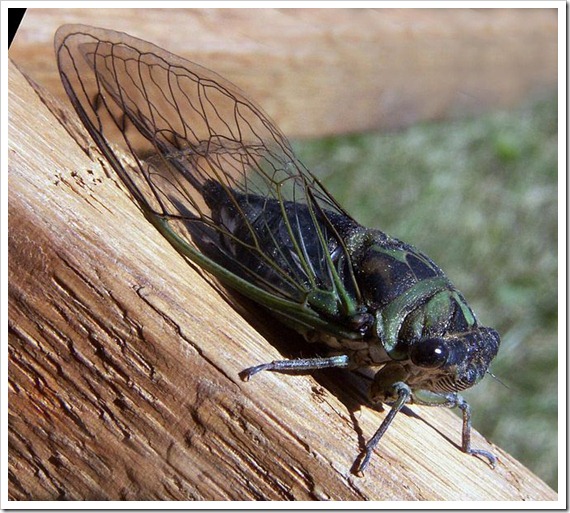La Cicala Posted by Serena on Jun 29, 2011 in Uncategorized
It’s official, summer is here. The announcement was made a few days ago by la cicala (the cicada). Throughout the hot days of summer and into the autumn il frinio, the monotonous strident song of the cicala can nearly always be heard somewhere in the background. It’s a sound that I’ve always taken for granted, and even though it’s not the most musical of melodies I love it because for me it is ‘the sound of summer’.
But what exactly is una cicala, and how can something that makes so much noise be so difficult to spot?
La cicala (Lyristes plebejus)
La cicala is a fairly large insect, usually between 2.5 and 5.5 cm long, but due to the fact that it is di colore marrone scuro o verde (dark brown or green in color) and that it lives sugli alberi di diversa specie e sulla vegetazione (on various types of trees and vegetation) it is, naturally, very difficult to find.
Sopra: Una cicala. Ha due paia di ali trasparenti e membranose che a riposo vengono tenute a tetto al di sopra del corpo
Above: A cicada. It has two pairs of transparent membranous wings that when resting are kept in a roof shape above its body.
If you are lucky enough to spot a cicala in action you will see, and hear, something like this:
http://www.youtube.com/watch?v=z3CoEmajF4w&feature=related
E come produce quel suono? (And how does it make that sound?)
Well the noisy ones are i maschi (the males) who portano sotto l’addome un organo stridulatore (carry beneath their abdomen a stridulation organ)
The organo stridulatore works in the following way:
L’organo stridulatore è situato ventralmente all’inizio dell’addome, quasi sempre protetto da un paio di larghe piastre protettive, gli opercoli. Sollevati gli opercoli ci sono due cavità per ciascun lato: una più grande ventrale, ed una più piccola laterale. All’interno sono presenti sottili membrane e dei sacchi aerei. Un paio di poderosi muscoli, fra i più potenti descritti nel Regno Animale, si collegano alla membrana e contraendosi producono vibrazioni da cui deriva il famoso frinio che sentiamo.
The stridulation organ is situated beneath the beginning of the abdomen and is almost always protected by a pair of wide protective plates, called opercula. Beneath the opercula are two cavities on each side: a large ventral one, and a smaller lateral one. Inside, are thin membranes and some air sacks. A pair of strong muscles, amongst the most powerful known in the Animal Kingdom, are connected to the membrane and by contracting they produce the vibrations which create the famous sound that we hear.
The female, on the other hand, makes a much quieter sound by rustling her wings together. In this way she advertises her presence to the amorous male, who then attracts her towards him with his clamorous racket. This is the part in the movies where the bedroom light is extinguished and we are left to our imaginations until we find the two lovers lying peacefully the following morning with their twelve legs and eight wings entwined. Suffice it to say that some 24 hours later the female begins to busily deposit her eggs on twigs and branches.
Once hatched, le larve (the larvae) begin their underground work of moving from root to root and feeding on la linfa (sap). This phase lasts for several years (up to 17 in some species!) at the end of which they emerge from the soil and find a nice branch on which they can complete their mutation into the adult cicala. Gli adulti continuano a nutrirsi della linfa degli alberi e a tal scopo usano la loro proboscide. The adults continue to feed on the sap of trees and for that purpose they use their proboscis.
Sopra: L’involucro vuoto di una cicala
Above: The empty shell of a cicada
In part two I’ll be looking at some of the detti (sayings) and proverbi (proverbs) that feature la cicala.
Rimanete sintonizzati!

Build vocabulary, practice pronunciation, and more with Transparent Language Online. Available anytime, anywhere, on any device.






Comments:
Jerry:
Serena, I couldn’t agree more. These creatures, even though they are insects, make bella musica in estate.
Andreas:
Salve Serena!
Anche a me piace il frinio delle cicale. E dopo aver ascolatato la canzone de Kiri te Kanawa sulle cicale ‘Tarakihi’, ho scoperto tutta una mitilogia di ciale di vari popoli.
Andreas
Fern Driscoll:
Fantastic photo and video of cicadas – thank you so much for this. I’ve always wondered about them, especially how they make that terrific racket – and now I know! The wings are so pretty…